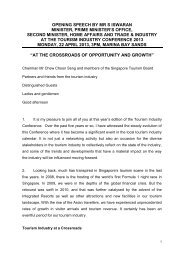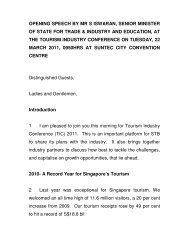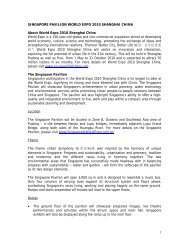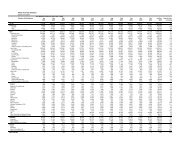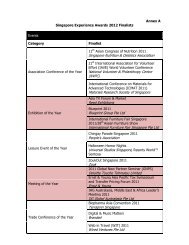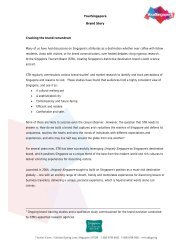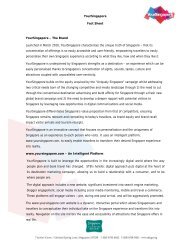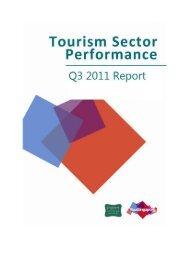i'mpact Singapore Tourism Board Annual Report 2010/2011
i'mpact Singapore Tourism Board Annual Report 2010/2011
i'mpact Singapore Tourism Board Annual Report 2010/2011
You also want an ePaper? Increase the reach of your titles
YUMPU automatically turns print PDFs into web optimized ePapers that Google loves.
NOTES TO THE FINANCIAL STATEMENTS<br />
31 March <strong>2011</strong><br />
SB-FRS 24 (Revised) Related Party Disclosures is effective for annual periods beginning on or after January 1, <strong>2011</strong>.<br />
The revised standard clarifies the definition of a related party and consequently additional parties may be identified as<br />
related to the reporting entity.<br />
Where the exemption applies for government related entities (in relation to the disclosure of transactions, outstanding<br />
balances and commitments) the reporting entity has to make additional disclosure, including the nature of the relationship<br />
between STB and the government related entities and information on significant transactions or group of transactions<br />
involved.<br />
In the period of initial adoption, the changes to related party disclosures, if any, will be applied retrospectively with<br />
restatement of the comparative information.<br />
Management has considered and is of the view that the adoption of the SB-FRSs, INT SB-FRSs and Amendments to<br />
SB-FRSs that were issued at the date of authorisation of these financial statements but not effective until future periods<br />
will have no material impact on the financial statements in the period of their initial adoption.<br />
(b)<br />
FINANCIAL INSTRUMENTS<br />
Financial assets and financial liabilities are recognised in the statement of financial position when STB becomes a party to<br />
the contractual provisions of the instrument.<br />
Effective interest method<br />
The effective interest method is a method of calculating the amortised cost of a financial instrument and of allocating<br />
interest income or expense over the relevant period. The effective interest rate is the rate that exactly discounts estimated<br />
future cash receipts or payments (including all fees paid or received that form an integral part of the effective interest<br />
rate, transaction costs and other premium or discounts) through the expected life of the financial instrument, or where<br />
appropriate, a shorter period. Income and expenses are recognised on an effective interest basis for debt instruments.<br />
Financial assets<br />
Investments are recognised and de-recognised on a trade date where the purchase or sale of an investment is under a<br />
contract whose terms require delivery of the investment within the timeframe established by the market concerned, and<br />
are initially measured at fair value plus transaction costs, except for those financial assets classified as at fair value through<br />
profit or loss which are initially measured at fair value.<br />
Other financial assets are classified into the following specified categories: financial assets “at fair value through profit<br />
or loss, “available-for-sale” financial assets and “loans and receivables”. The classification depends on the nature and<br />
purpose of financial assets and is determined at the time of initial recognition.<br />
65





